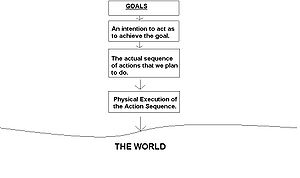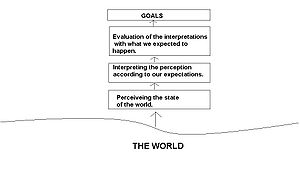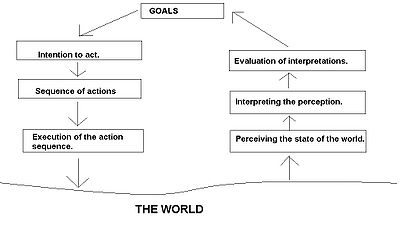
Seven stages of action
Encyclopedia
Seven stages of action is a term coined by the usability
consultant Donald Norman
.
He explains this phrase in chapter two of his book The Design of Everyday Things
, in the context of explaining the psychology of a person behind the task performed by him or her.
attended by Donald Norman.
This excerpt has been taken from the book The Design of Everyday Things
:
Norman pondered on the reasons that made something like threading of a projector difficult to do. To examine this, he wanted to know what happened when something implied nothing. In order to do that, he examined the structure of an action. So to get something done, a notion of what is wanted – the goal that is to be achieved, needs to be started. Then, something is done to the world i.e. take action to move oneself or manipulate someone or something. Finally, the checking is required if the goal was made. This led to formulation of Stages of Execution and Evaluation.
 Execution formally means to perform or do something. Norman explains that a person sitting on an armchair while reading a book during dusk time, might need more light when it becomes dimmer and dimmer. To do that, he needs to switch on the button of a lamp i.e. get more light (the goal
Execution formally means to perform or do something. Norman explains that a person sitting on an armchair while reading a book during dusk time, might need more light when it becomes dimmer and dimmer. To do that, he needs to switch on the button of a lamp i.e. get more light (the goal
). To do this, one must need to specify on how to move one's body, how to stretch to reach the light switch and how to extend one's finger to push the button. The goal has to be translated into an intention, which in turn has to be made into an action sequence.
Thus, formulation of stages of execution:-
 Evaluation
Evaluation
formally means to examine and calculate. Norman explains that after turning on the light, we evaluate if it is actually turned on. A careful judgement is then passed on how the light has affected our world i.e. the room in which the person is sitting on the armchair while reading a book.
The formulation of the stages of evaluation can be described as:-
 Seven Stages of Action constitute three stages of execution, three stages of evaluation and our goals.
Seven Stages of Action constitute three stages of execution, three stages of evaluation and our goals.
1. Forming the goal
2. Forming the intention
3. Specifying an action
4. Executing the action
5. Perceiving the state of the world
6. Interpreting the state of the world
7. Evaluating the outcome http://cmapspublic.ihmc.us/servlet/SBReadResourceServlet?rid=1165167923187_663887047_11513&partName=htmltext
.
reflects the amount of effort that the person must exert to interpret the physical state of the system and to determine how well the expectations and intentions have been met.
The Seven Stages of Action can be broken down into 4 main principles of good design:-
Usability
Usability is the ease of use and learnability of a human-made object. The object of use can be a software application, website, book, tool, machine, process, or anything a human interacts with. A usability study may be conducted as a primary job function by a usability analyst or as a secondary job...
consultant Donald Norman
Donald Norman
Donald Arthur Norman is an academic in the field of cognitive science, design and usability engineering and a co-founder and consultant with the Nielsen Norman Group. He is the author of the book The Design of Everyday Things....
.
He explains this phrase in chapter two of his book The Design of Everyday Things
The Design of Everyday Things
The Design of Everyday Things is a best-selling book by cognitive scientist and usability engineer Donald Norman about the design of simple objects, and why some objects please their users while others frustrate them....
, in the context of explaining the psychology of a person behind the task performed by him or her.
History
The history behind the action cycle starts from a conference in ItalyItaly
Italy , officially the Italian Republic languages]] under the European Charter for Regional or Minority Languages. In each of these, Italy's official name is as follows:;;;;;;;;), is a unitary parliamentary republic in South-Central Europe. To the north it borders France, Switzerland, Austria and...
attended by Donald Norman.
This excerpt has been taken from the book The Design of Everyday Things
The Design of Everyday Things
The Design of Everyday Things is a best-selling book by cognitive scientist and usability engineer Donald Norman about the design of simple objects, and why some objects please their users while others frustrate them....
:
I am in Italy at a conference. I watch the next speaker attempt to thread a film onto a projector that he never used before. He puts the reel into place, then takes it off and reverses it. Another person comes to help. Jointly they thread the film through the projector and hold the free end, discussing how to put it on the takeup reel. Two more people come over to help and then another. The voices grow louder, in three languages: Italian, German and English. One person investigates the controls, manipulating each and announcing the result. Confusion mounts. I can no longer observe all that is happening. The conference organizer comes over. After a few moments he turns and faces the audience, which has been waiting patiently in the auditorium. "Ahem," he says, "is anybody expert in projectors?" Finally, fourteen minutes after the speaker had started to thread the film (and eight minutes after the scheduled start of the session) a blue-coated technician appears. He scowls, then promptly takes the entire film off the projector, rethreads it, and gets it working.
Norman pondered on the reasons that made something like threading of a projector difficult to do. To examine this, he wanted to know what happened when something implied nothing. In order to do that, he examined the structure of an action. So to get something done, a notion of what is wanted – the goal that is to be achieved, needs to be started. Then, something is done to the world i.e. take action to move oneself or manipulate someone or something. Finally, the checking is required if the goal was made. This led to formulation of Stages of Execution and Evaluation.
Stages of Execution

Goal
A goal is an objective, or a projected computation of affairs, that a person or a system plans or intends to achieve.Goal, GOAL or G.O.A.L may also refer to:Sport...
). To do this, one must need to specify on how to move one's body, how to stretch to reach the light switch and how to extend one's finger to push the button. The goal has to be translated into an intention, which in turn has to be made into an action sequence.
Thus, formulation of stages of execution:-
- Start at the top with the goal, the state that is to be achieved.
- The goal is translated into an intentionIntentionIntention is an agent's specific purpose in performing an action or series of actions, the end or goal that is aimed at. Outcomes that are unanticipated or unforeseen are known as unintended consequences....
to do some action. - The intention must be translated into a set of internal commands, an action sequence that can be performed to satisfy the intention.
- The action sequence is still a mutual even: nothing happens until it is executed, performed upon the world.
Stages of Evaluation

Evaluation
Evaluation is systematic determination of merit, worth, and significance of something or someone using criteria against a set of standards.Evaluation often is used to characterize and appraise subjects of interest in a wide range of human enterprises, including the arts, criminal justice,...
formally means to examine and calculate. Norman explains that after turning on the light, we evaluate if it is actually turned on. A careful judgement is then passed on how the light has affected our world i.e. the room in which the person is sitting on the armchair while reading a book.
The formulation of the stages of evaluation can be described as:-
- Evaluation starts with our perceptionPerceptionPerception is the process of attaining awareness or understanding of the environment by organizing and interpreting sensory information. All perception involves signals in the nervous system, which in turn result from physical stimulation of the sense organs...
of the world. - This perception must then be interpreted according to our expectations.
- Then it is compared (evaluated) with respect to both our intentions and our goals.
Seven Stages of Action

1. Forming the goal
2. Forming the intention
3. Specifying an action
4. Executing the action
5. Perceiving the state of the world
6. Interpreting the state of the world
7. Evaluating the outcome http://cmapspublic.ihmc.us/servlet/SBReadResourceServlet?rid=1165167923187_663887047_11513&partName=htmltext
The Gulf of Execution
The difference between the intentions and the allowable actions is the Gulf of executionGulf of execution
Gulf of execution is a term usually used in human computer interaction to describe the gap between a user's goal for action and the means to execute that goal...
.
"Consider the movie projector example: one problem resulted from the Gulf of Execution. The person wanted to set up the projector. Ideally, this would be a simple thing to do. But no, a long, complex sequence was required. It wasn't all clear what actions had to be done to accomplish the intentions of setting up the projector and showing the film."
The Gulf of Evaluation
The Gulf of evaluationGulf of evaluation
In computer science, the gulf of evaluation is the degree to which the system/artifact provides representations that can be directly perceived and interpreted in terms of the expectations and intentions of the user...
reflects the amount of effort that the person must exert to interpret the physical state of the system and to determine how well the expectations and intentions have been met.
"In the movie projector example there was also a problem with the Gulf of Evaluation. Even when the film was in the projector, it was difficult to tell if it had been threaded correctly."
Usage as Design Aids
The seven-stage structure is referenced as design aid to act as a basic checklist for designers' questions to ensure that the Gulfs of Execution and Evaluation are bridged.The Seven Stages of Action can be broken down into 4 main principles of good design:-
- VisibilityVisibilityIn meteorology, visibility is a measure of the distance at which an object or light can be clearly discerned. It is reported within surface weather observations and METAR code either in meters or statute miles, depending upon the country. Visibility affects all forms of traffic: roads, sailing...
- By looking, the user can tell the state of the device and the alternatives for action. - A Good Conceptual Model - The designer provides a good conceptual model for the user, with consistency in the presentation of operations and results and a coherent, consistent system image.
- Good mappings - It is possible to determine the relationships between actions and results, between the controls and their effects, and between the system state and what is visible.
- FeedbackFeedbackFeedback describes the situation when output from an event or phenomenon in the past will influence an occurrence or occurrences of the same Feedback describes the situation when output from (or information about the result of) an event or phenomenon in the past will influence an occurrence or...
- The user receives full and continuous feedback about the results of the actions.
See also
- AffordanceAffordanceAn affordance is a quality of an object, or an environment, which allows an individual to perform an action. For example, a knob affords twisting, and perhaps pushing, while a cord affords pulling...
- Executive system
- Usability engineeringUsability engineeringUsability engineering is a field that is concerned generally with human-computer interaction and specifically with making human-computer interfaces that have high usability or user friendliness...
- Human action cycleHuman action cycleThe human action cycle is a psychological model which describes the steps humans take when they interact with computer systems. The model was proposed by Donald A. Norman, a scholar in the discipline of human-computer interaction. The model can be used to help evaluate the efficiency of a user...
- Human-computer interaction
- Interaction DesignInteraction designIn design, human–computer interaction, and software development, interaction design, often abbreviated IxD, is "the practice of designing interactive digital products, environments, systems, and services." Like many other design fields interaction design also has an interest in form but its main...
- User-centered designUser-centered designIn broad terms, user-centered design or pervasive usability is a design philosophy and a process in which the needs, wants, and limitations of end users of a product are given extensive attention at each stage of the design process...
- VisibilityVisibilityIn meteorology, visibility is a measure of the distance at which an object or light can be clearly discerned. It is reported within surface weather observations and METAR code either in meters or statute miles, depending upon the country. Visibility affects all forms of traffic: roads, sailing...
- UsabilityUsabilityUsability is the ease of use and learnability of a human-made object. The object of use can be a software application, website, book, tool, machine, process, or anything a human interacts with. A usability study may be conducted as a primary job function by a usability analyst or as a secondary job...
- Gulf of evaluationGulf of evaluationIn computer science, the gulf of evaluation is the degree to which the system/artifact provides representations that can be directly perceived and interpreted in terms of the expectations and intentions of the user...
- Gulf of executionGulf of executionGulf of execution is a term usually used in human computer interaction to describe the gap between a user's goal for action and the means to execute that goal...
External links
- Don's homepage
- Publications by Donald Norman from Interaction-Design.org
- List of Don Norman articles
- Don Norman — Userati
- Donald Norman's Seven Stages of Action - What are Norman's Seven Stages
- University of Hawaii's Lecture on Donald Norman's book
- Monash University's 2003 Monash Web Workshop Series' Lecture on Usability and Human factors
- University of Limerick's (Ireland) lecture on Donald Norman

